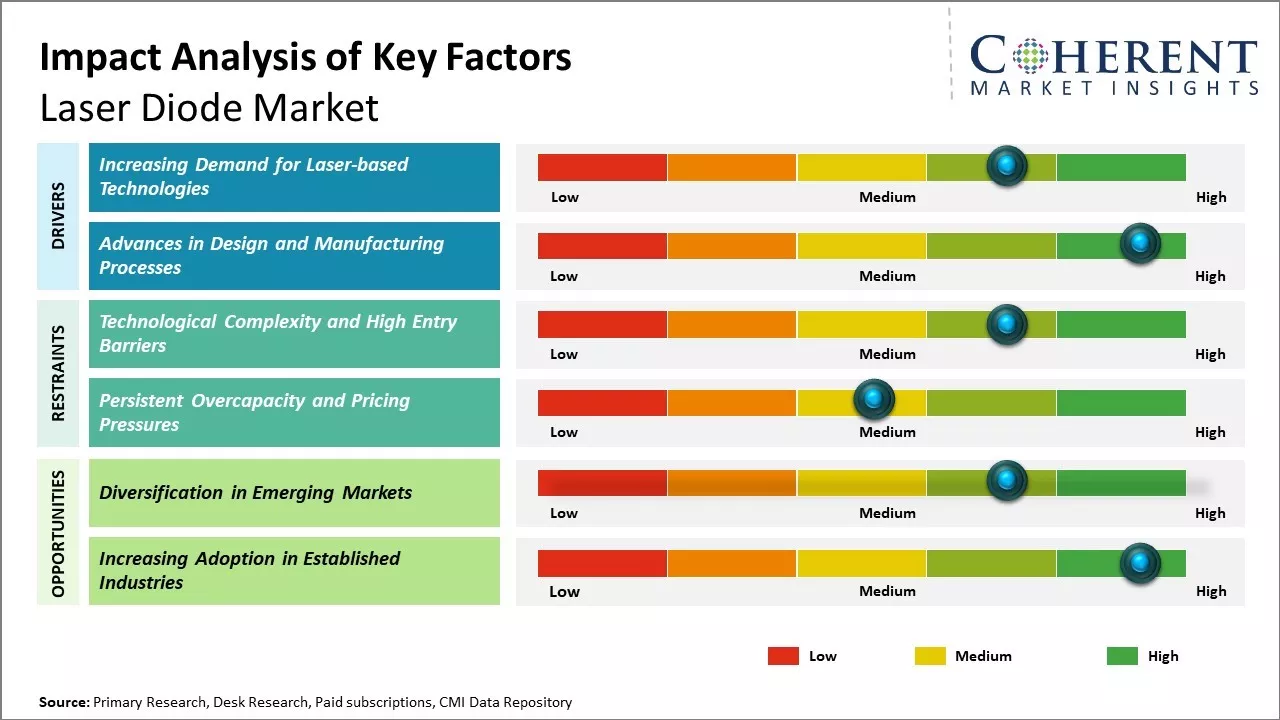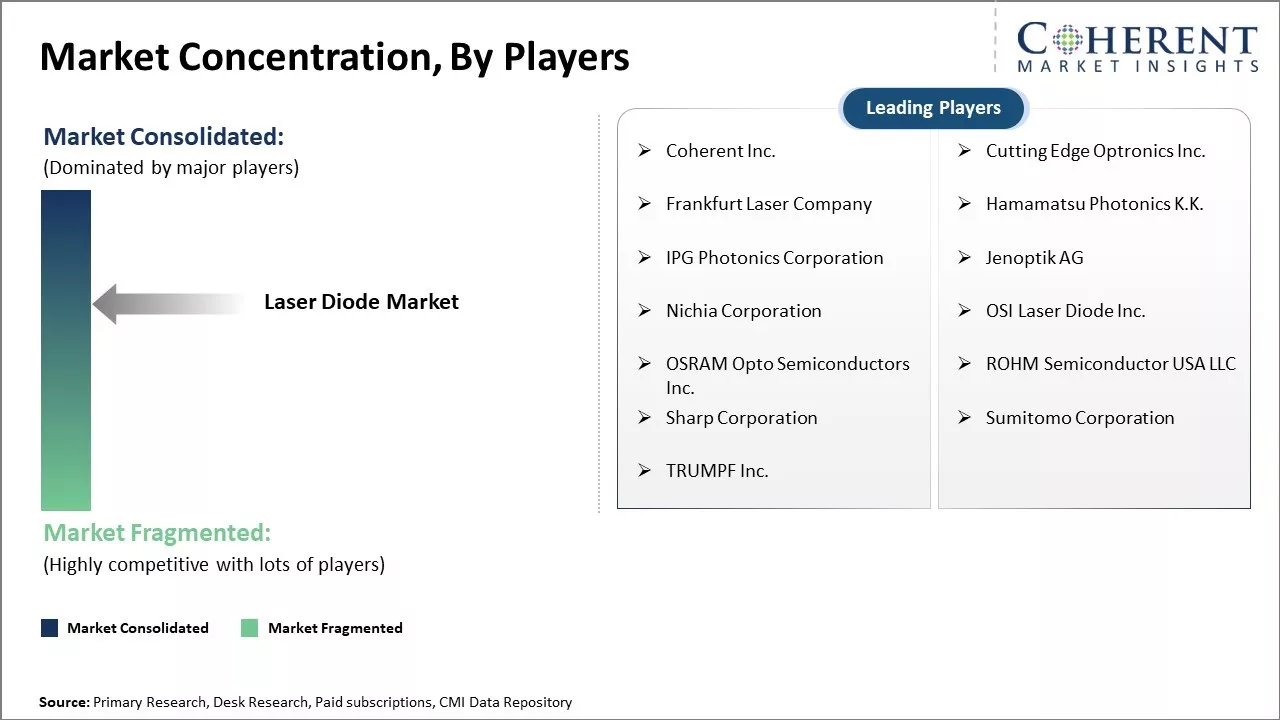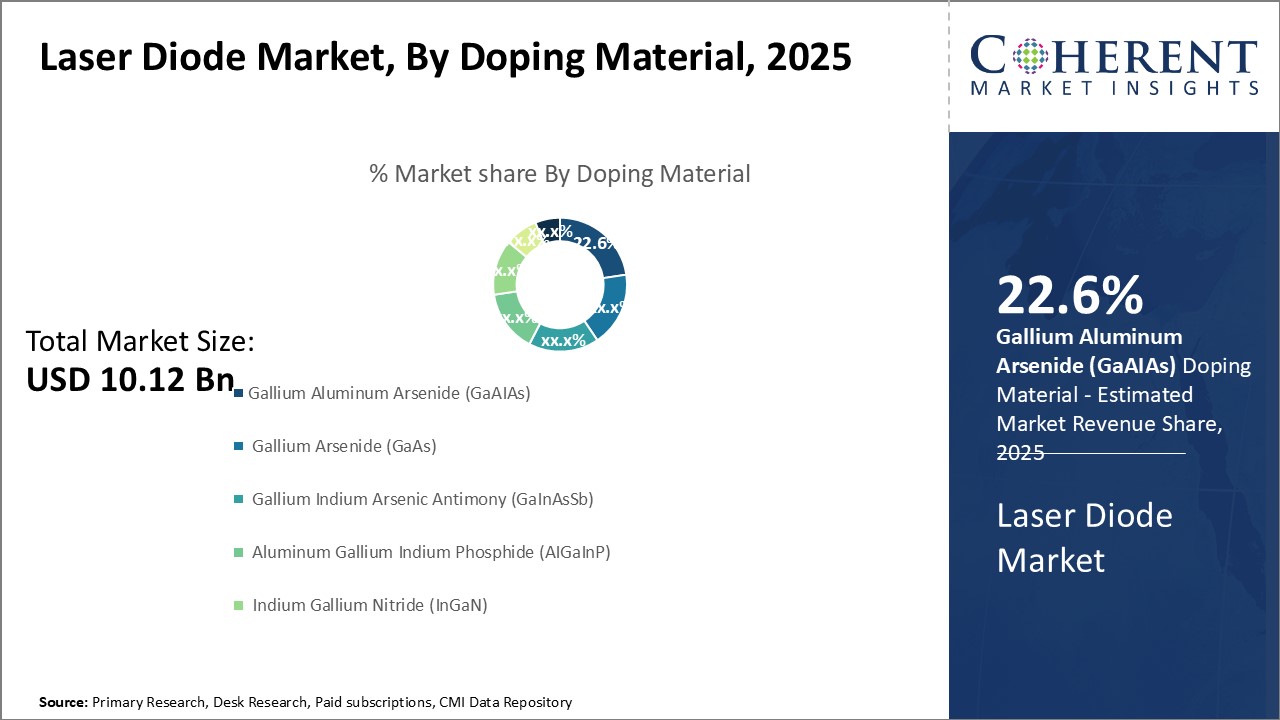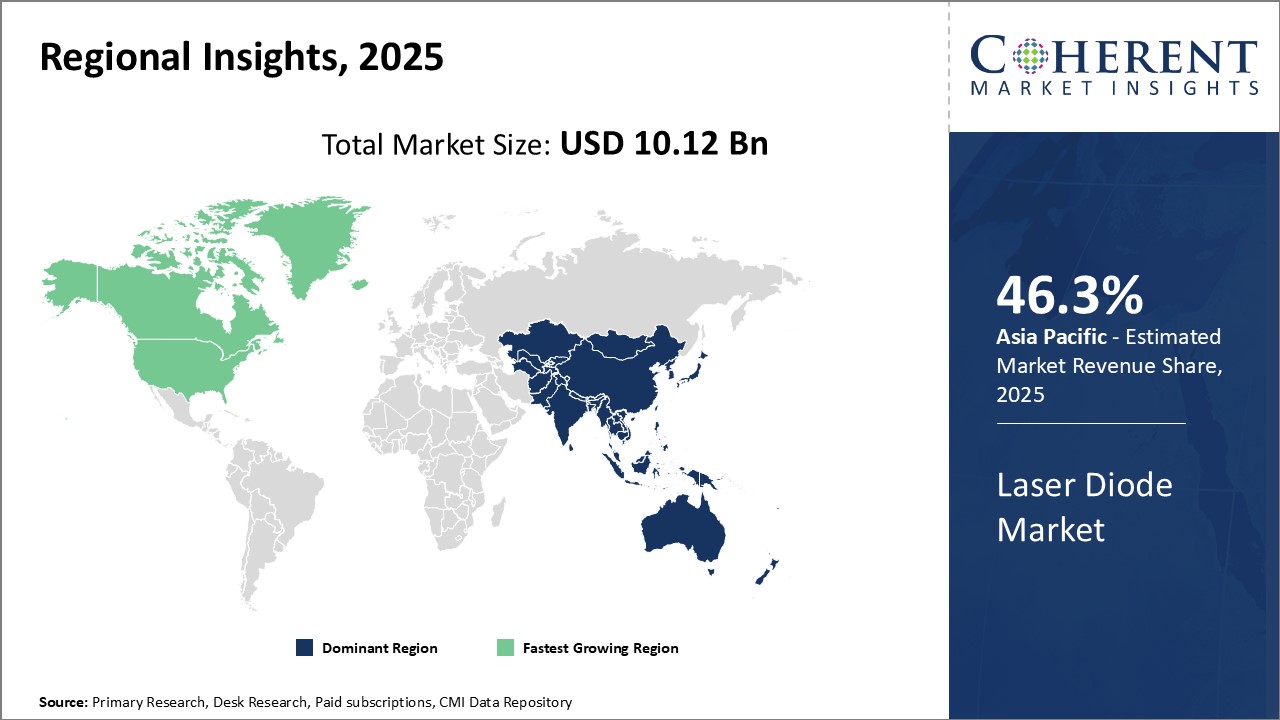The laser diode market is estimated to be valued at US$ 10.12 billion in 2025 and is expected to reach US$ 21.16 billion by 2032, exhibiting a compound annual growth rate (CAGR) of 11.1% from 2025 to 2032.

Discover market dynamics shaping the industry: Download Free Sample
The laser diode market is experiencing positive growth on account of the increasing demand from various sectors such as consumer electronics, defense, industrial, and medical. Laser diodes are increasingly being used in rangefinders, barcode scanners, optical mice, laser pointers, CD/DVD players, and medical devices such as aesthetic lasers. Advantages of laser diodes including high power density, wavelength selectivity and compatibility with optical fibers are increasing their adoption over traditional lighting solutions. Furthermore, technological advancements to improve optical power levels and efficiencies along with reduction in costs are expanding the application scope of laser diodes. Emerging applications in new areas including electric vehicles, LiDAR, and 3D sensing will further drive market revenues over the forecast period.
Increasing Demand for Laser-based Technologies
The global market for laser diodes has been experiencing steady growth over the past decade due to their widening range of applications across various industries. Laser diodes are increasingly being incorporated into many cutting-edge technologies where accurate optical transmission and precision are critical requirements. One of the major areas driving their demand is the laser projection market. As displays and projectors get more compact yet powerful, laser diodes have emerged as an ideal light source for illuminating high-resolution images over larger surfaces. Their ability to produce bright, coherent light that can be modulated electronically makes them suitable for advanced applications like laser TVs and holographic displays. Many consumer electronics brands are now embracing laser projection technology for their high-end televisions and home theatre systems.
Laser diodes are also powering the revolution in optical fiber communications networks. With internet traffic increasing exponentially worldwide, communication service providers are aggressively upgrading their infrastructure to accommodate higher bandwidth demands. Laser diodes mounted on pluggable optical transceivers play a crucial role in transmission systems that leverage the vast data carrying capabilities of optical fiber. Their longevity, reliability, and stability at high data rates have made them integral to the expansion of 4G/5G networks, hyperscale data centers, and fiber-to-the-home projects. Besides, the use of laser diodes in applications like laser pointer presentations, barcode scanners, bioimaging, and light detection and ranging (LiDAR) systems for self-driving cars has been on an upswing.

Get actionable strategies to beat competition: Download Free Sample
Advancements in Design and Manufacturing Processes
Significant progress in laser diode design approaches and fabrication techniques over the last few years have expanded the scope of their application into new commercial and industrial fields. New GaN-based laser diode structures that offer improved light conversion efficiency, wavelength control, and lumen maintenance compared to earlier InGaN/GaN designs have increased their competitive edge. In addition, laser diode manufacturers are constantly enhancing epitaxial growth methods, quantum well designs and packaging techniques to achieve higher output power levels, better thermal performance, and longer operational lifetimes. The ability to mass-produce more affordable, reliable laser diodes across various output wavelengths from blue to infrared has opened up new potential usage models.
Advanced manufacturing processes like micro-channel cooling have enabled the development of laser diode bars and stacks capable of delivering kilowatt-levels of continuous-wave optical power.
Key Takeways from Lead Analyst
The laser diode market is poised to grow at a steady pace over the next five years. The declining average selling prices of laser diodes along with their high energy efficiency is driving increased adoption across various application areas such as laser pointer, barcode scanners, optical disks, and semiconductor processing. The Asia Pacific region, especially China, is expected to dominate the laser diode market owing to the presence of leading manufacturing plants and a large consumer base.
The growing demand for laser-based treatment for various medical conditions is opening new avenues for market participants. Advancements in materials such as UV and blue lasers is expanding the application scope of laser diodes. However, high initial investments required for infrastructure and R&D activities might limit the entry of new players in the market.
Manufacturers are influenced to lower manufacturing costs through innovations in design and efficiencies. The rising need for laser-based 3D sensing technology in consumer electronics and automotive industry presents new revenue pockets. On the other hand, trade barriers and international tariffs could threaten the supply chain of certain component manufacturers. Laser players need to focus on developing next-generation diode materials to tap the opportunities arising from demand for high-power applications.
Market Challenges: Technological Complexity and High Entry Barriers
Laser diodes, being technologically intricate components, demand highly specialized manufacturing facilities and processes. Consequently, the market presents substantial entry barriers for new companies due to the significant investment required to establish such facilities. These high operating costs act as deterrents, limiting the entry of potential competitors into the market.
Market Opportunities: Diversification in Emerging Markets
The emergence of applications in sectors such as biomedical equipment, LiDAR technology, laser projectors, and 3D sensing is generating new demand streams for laser technology. These expanding markets present lucrative opportunities for companies to diversify their product offerings and cater to the evolving needs of various industries. Moreover, the proliferation of laser materials processing and laser-based additive manufacturing processes further enhances the scope for innovation and growth in this domain.

Discover high revenue pocket segments and roadmap to it: Download Free Sample
By Doping Material - Increasing use of customized laser diodes for specific applications
The laser diode market utilizes a variety of doping materials to achieve the desired optical and electronic properties necessary for different applications. Among these, Gallium Aluminum Arsenide (GaAlAs) stands out as the dominant material in 2025, capturing a market share of 22.6%. GaAlAs is widely used in telecommunications, optical data storage, and medical devices due to its ability to emit light in the near-infrared spectrum and superior temperature stability. Gallium Arsenide (GaAs) is known for its high electron mobility and direct bandgap properties, making it ideal for high-frequency and high-power applications, such as fiber optic communication and infrared remote controls. Gallium Indium Arsenic Antimony (GaInAsSb) is crucial for mid-infrared laser diodes used in gas sensing and environmental monitoring. Aluminum Gallium Indium Phosphide (AlGaInP) is employed in visible light laser diodes for applications like DVD players and laser pointers. Indium Gallium Nitride (InGaN) produces blue and green laser diodes for high-density data storage and solid-state lighting. Gallium Nitride (GaN) is suitable for ultraviolet and blue laser diodes used in industrial cutting and high-resolution printing due to its robustness and high-power capabilities. Other materials include Indium Gallium Arsenide Phosphide (InGaAsP) for telecommunications and photonic integrated circuits, Gallium Phosphide (GaP) for LEDs and some laser diodes, and Gallium Antimonide (GaSb) for infrared applications. These materials collectively enable the diverse functionalities and applications of laser diodes across various industries, driving technological advancements and market growth.
By Technology - Emergence of VECSEL technology for high power applications
In terms of technology, VECSEL diodes is expected to contribute the highest share of 28.7% in 2025, owing to their ability to scale to high output power levels while maintaining excellent beam quality compared to other laser diode technologies. VECSELs leverage a gain chip and external cavity design to dissipate heat extremely efficiently. This helps mitigate thermal effects that typically plague high power diodes. As a result, continuous wave output powers exceeding 50 Watts from a single emitter have been demonstrated, outperforming other high power options. VECSELs also provide nearly perfect TEM00 beam profiles vital for applications like materials processing. Recent innovations in wafer bonding and doping profiles have enabled rapid progress in VECSEL technology. Efficient devices spanning visible to mid-IR have expanded applications in printing, machining, cutting, medical aesthetics and spectroscopy. With continued device/process developments, VECSELs are poised to dominate emerging high brightness applications that demand >10 Watts of continuous power.
By Application - Growing digitalization and 5G driving lasers in telecommunications
In terms of application, IT & telecommunication is expected to contribute the highest share of 26% in 2025, owing to the central role played by laser diodes in digital connectivity infrastructure. As more devices connect to the internet, the demand for high speed data transmission over fiber optic networks continues to surge. This is driving the rapid uptake of advanced laser diode types capable of high modulation bandwidths essential for meeting explosion in network traffic and speeds required for 5G, cloud computing, IoT, etc. DFB lasers remain the workhorse transmitters for long haul undersea/terrestrial fiber links though complex modulation formats. Mode-locked lasers generating ultra-short optical pulses are deployed in emerging coherent transmission systems utilizing advanced modulation schemes. Edge emitters and VCSELs extensively populate datacenter links and switch fabrics for their compact size and low power operation. Meanwhile fiber lasers are growing rapidly for amplification applications in long haul networks. Overall, laser diodes have evolved into an indispensable component of the digital revolution, supporting transformation across various spheres through ubiquitous high speed connectivity underpinned by fiber optic networks. Their further advancements remain crucial to accommodating insatiable global bandwidth demand in the coming years.

Need a Different Region or Segment? Download Free Sample
In 2025, Asia Pacific to maintain its position as the leading region in the laser diode market, projected to hold the largest market share of 46.3% among all other regions. This dominance reflects the region's dynamic industrial landscape, marked by rapid technological advancements and robust economic growth. With countries like China, Japan, and South Korea at the forefront of innovation and manufacturing, Asia Pacific continues to witness significant demand for laser diodes across various applications, including telecommunications, consumer electronics, and automotive industries.
Furthermore, Asia Pacific is poised to exhibit the highest Compound Annual Growth Rate (CAGR) of 12.6% in 2025, surpassing all other regions. This accelerated growth trajectory underscores the region's pivotal role in driving the expansion of the global laser diode market. Factors such as increasing investments in research and development, coupled with the burgeoning demand for high-performance electronic devices and advanced manufacturing technologies, contribute to the robust growth prospects in Asia Pacific.
As industries across Asia Pacific increasingly embrace automation, digitalization, and emerging technologies, the demand for laser diodes is expected to soar, particularly in sectors like industrial manufacturing, healthcare, and telecommunications. Moreover, supportive government initiatives, favorable regulatory policies, and strategic collaborations among key industry players further bolster the growth momentum in the region. With Asia Pacific emerging as a powerhouse for innovation and production, the laser diode market is anticipated to witness sustained growth and significant opportunities for stakeholders across the value chain.
Laser Diode Market Report Coverage
| Report Coverage | Details | ||
|---|---|---|---|
| Base Year: | 2024 | Market Size in 2025: | USD 10.12 Bn |
| Historical Data for: | 2020 To 2024 | Forecast Period: | 2025 To 2032 |
| Forecast Period 2025 to 2032 CAGR: | 11.1% | 2032 Value Projection: | USD 21.16 Bn |
| Geographies covered: |
|
||
| Segments covered: |
|
||
| Companies covered: |
Coherent Inc., Cutting Edge Optronics Inc., Frankfurt Laser Company, Hamamatsu Photonics K.K., IPG Photonics Corporation, Jenoptik AG, Nichia Corporation, OSI Laser Diode Inc., OSRAM Opto Semiconductors Inc., ROHM Semiconductor USA LLC, Sharp Corporation, Sumitomo Corporation, TRUMPF Inc. |
||
| Growth Drivers: |
|
||
| Restraints & Challenges: |
|
||
Uncover macros and micros vetted on 75+ parameters: Get instant access to report
*Definition: The laser diode market involves the production and sale of semiconductor-based laser diodes. Laser diodes are semiconductor devices that emit coherent light through stimulated emission when electric current flows through them. They are commonly used in laser pointers, fiber optic communication systems, CD/DVD players, laser printers, barcode scanners, and laser surgery equipment. The laser diode market is expected to continue growing driven by increasing applications in industrial manufacturing, medical devices, telecommunication networks, and consumer electronics.
Share
Share
About Author
As an accomplished Senior Consultant with 7+ years of experience, Pooja Tayade has a proven track record in devising and implementing data and strategy consulting across various industries. She specializes in market research, competitive analysis, primary insights, and market estimation. She excels in strategic advisory, delivering data-driven insights to help clients navigate market complexities, optimize entry strategies, and achieve sustainable growth.
Missing comfort of reading report in your local language? Find your preferred language :
Transform your Strategy with Exclusive Trending Reports :
Frequently Asked Questions
Joining thousands of companies around the world committed to making the Excellent Business Solutions.
View All Our Clients